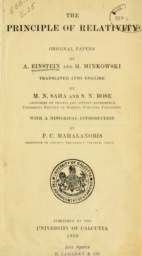

The Principle of Relativity (1920)
by Albert Einstein and H. Minkowski


The fundamental electro-magnetic equations of Maxwell for stationary media are:⏎ ⏎ curl H = 1/c (dD/dt + pv) (1)⏎ curl E = -1/c dB/dt (2)⏎ div D = p⏎ B = uH⏎ div B = 0⏎ D = kE⏎ According to Hertz and Heaviside, these require modification in the case of moving bodies.⏎ ⏎ Now it is known that due to motion alone there is a change in a vector R given by⏎ ⏎ (dR/dt) due to motion = u. div R + curl [Ru]⏎ where u is the vector velocity of the moving body and [Ru] the vector product of R and u.⏎ ⏎ Hence equations (1) and (2) become⏎ ⏎ c curl H = dD/dt + u div D + curl Vect. [Du] + pv (1x1)⏎ and⏎ ⏎ -c curl E = dB/dt + u div B + curl Vect. [Bu] (2x1)⏎ which gives finally, for p = 0 and div B = 0,⏎ ⏎ dD/dt + u div D = c curl (H - 1/c Vect. [Du]) (1x2)⏎ dB/dt = -c curl (E - 1/c Vect. [uB]) (2x2)⏎ Let us consider a beam travelling along the x-axis, with apparent velocity v (i.e., velocity with respect to the fixed ether) in medium moving with velocity ux = u in the same direction.⏎ ⏎ Then if the electric and magnetic vectors are proportional to eiA(x - vt), we have⏎ ⏎ d/dx = iA, d/dt = -iAv, d/dy = d/dz = 0, uy = uz = 0⏎ Then dD_y/dt = -cdHz/dx - udDy/dz ... (1x21)⏎ and dBz/dt = -cdEy/dx - udBz/dx (2x21)⏎ Since D = KE and B = uH, we have⏎ ⏎ iAv(kEy) = -ciA(Hz + uKEy) (1x22)⏎ iAv(uHz) = -ciA(Ey + uuHz) (2x22)⏎ or v(K - u)Ey = cHz (1x23)⏎ u(v - u)Hz = cEy (2x23)⏎ Multiplying (1x23) by (2x23)⏎ ⏎ uK(v - u)^2 = c^2⏎ Hence (v - u)^2 = c^2/uk = v0^2⏎ ⏎ QED v = v_0 + u,⏎ ⏎ making Fresnelian convection co-efficient simply unity.🏁
Global Leaderboard
| # | Player | Time | Duration | Accuracy | WPM | pp | |
|---|---|---|---|---|---|---|---|
| 1 | |||||||
| 2 | |||||||
| 3 | |||||||
| 4 | |||||||
| 5 | |||||||
| 6 | |||||||
| 7 | |||||||
| 8 | |||||||
| 9 | |||||||
| 10 |


The fundamental electro-magnetic equations of Maxwell for stationary media are:⏎ ⏎ curl H = 1/c (dD/dt + pv) (1)⏎ curl E = -1/c dB/dt (2)⏎ div D = p⏎ B = uH⏎ div B = 0⏎ D = kE⏎ According to Hertz and Heaviside, these require modification in the case of moving bodies.⏎ ⏎ Now it is known that due to motion alone there is a change in a vector R given by⏎ ⏎ (dR/dt) due to motion = u. div R + curl [Ru]⏎ where u is the vector velocity of the moving body and [Ru] the vector product of R and u.⏎ ⏎ Hence equations (1) and (2) become⏎ ⏎ c curl H = dD/dt + u div D + curl Vect. [Du] + pv (1x1)⏎ and⏎ ⏎ -c curl E = dB/dt + u div B + curl Vect. [Bu] (2x1)⏎ which gives finally, for p = 0 and div B = 0,⏎ ⏎ dD/dt + u div D = c curl (H - 1/c Vect. [Du]) (1x2)⏎ dB/dt = -c curl (E - 1/c Vect. [uB]) (2x2)⏎ Let us consider a beam travelling along the x-axis, with apparent velocity v (i.e., velocity with respect to the fixed ether) in medium moving with velocity ux = u in the same direction.⏎ ⏎ Then if the electric and magnetic vectors are proportional to eiA(x - vt), we have⏎ ⏎ d/dx = iA, d/dt = -iAv, d/dy = d/dz = 0, uy = uz = 0⏎ Then dD_y/dt = -cdHz/dx - udDy/dz ... (1x21)⏎ and dBz/dt = -cdEy/dx - udBz/dx (2x21)⏎ Since D = KE and B = uH, we have⏎ ⏎ iAv(kEy) = -ciA(Hz + uKEy) (1x22)⏎ iAv(uHz) = -ciA(Ey + uuHz) (2x22)⏎ or v(K - u)Ey = cHz (1x23)⏎ u(v - u)Hz = cEy (2x23)⏎ Multiplying (1x23) by (2x23)⏎ ⏎ uK(v - u)^2 = c^2⏎ Hence (v - u)^2 = c^2/uk = v0^2⏎ ⏎ QED v = v_0 + u,⏎ ⏎ making Fresnelian convection co-efficient simply unity.🏁